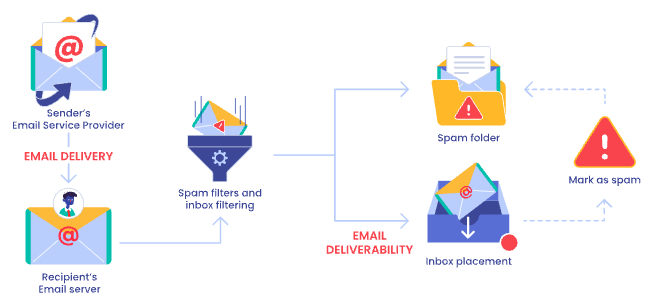Spam Checker
Use our Spam Checker to analyze emails for spam triggers and improve deliverability.
Spam Checker Guide to Avoiding Spam Filters
Understanding how spam filters work is essential for ensuring your emails reach their intended recipients. This Spam Checker guide provides insights into common spam triggers and best practices for email deliverability.

How Spam Checker Works with Spam Filters
Modern spam filters use a combination of techniques that our Spam Checker analyzes to identify unwanted emails. These include content analysis, sender reputation, technical indicators, and user behavior to determine if an email should be delivered to the inbox or sent to spam.
- Content analysis examines words, phrases, and formatting associated with spam
- Sender reputation evaluates the history of your sending domain and IP address
- Technical checks look for proper authentication records (SPF, DKIM, DMARC)
- User engagement considers how recipients interact with your previous emails
- Machine learning algorithms analyze patterns across millions of emails
Common Trigger Words Identified by Spam Checker
Spam Checker Warning: Avoid These Trigger Words
Certain words and phrases are strongly associated with spam. While using them occasionally won't automatically trigger filters, excessive use increases the risk of your email being flagged by Spam Checker.
- Financial terms: "free," "cash," "million dollars," "discount," "save money"
- Urgency language: "act now," "limited time," "once in a lifetime," "don't miss out"
- Excessive promises: "guaranteed," "risk-free," "satisfaction guaranteed"
- Health-related: "weight loss," "viagra," "medications," "cure," "miracle"
- Attention-grabbing: "amazing," "incredible," "revolutionary," "breakthrough"
Format Your Emails Properly According to Spam Checker
How you format your email can significantly impact its deliverability in Spam Checker tests. Even legitimate content can be flagged if formatted like typical spam.
- Avoid ALL CAPS in subject lines or body text
- Limit the use of exclamation marks (especially multiple!!!!!)
- Maintain a balanced text-to-image ratio
- Don't hide text with the same color as the background
- Use proper HTML if sending formatted emails
Email Deliverability and Spam Checker
Email deliverability is about much more than passing a Spam Checker test. Technical setup plays a crucial role in whether your emails reach their destination.
Sender Reputation in Spam Checker Assessment
Your sending domain and IP address build a reputation over time. Positive engagement helps your reputation, while spam complaints and bounces damage it and affect Spam Checker results.
Email Authentication for Spam Checker
Proper authentication helps mailbox providers verify that your emails are legitimate and not spoofed. This includes SPF, DKIM, and DMARC records that Spam Checker can help verify.

Technical Best Practices for Passing Spam Checker Tests
Beyond content, technical factors significantly impact deliverability and Spam Checker results. Implementing these best practices helps ensure your emails are trusted by receiving mail servers.
- Set up proper authentication records (SPF, DKIM, DMARC)
- Use a consistent sending domain and IP address
- Keep your email list clean and up to date
- Monitor your sender reputation regularly
- Ensure your email template is responsive and properly coded
Spam Checker Conclusion
By implementing these best practices and understanding how Spam Checker evaluates emails, you can maximize your chances of reaching your recipients successfully.
Spam Checker FAQs
What is the Spam Checker tool?
The Spam Checker analyzes email content for patterns and characteristics commonly found in spam messages. It helps identify elements that might trigger spam filters and prevent your email from reaching your recipients' inboxes.
How does this Spam Checker work?
The Spam Checker analyzes your email content using pattern matching to identify common spam triggers. It looks for suspicious language, promotional phrases, excessive formatting, and other elements often found in spam emails.
Why is using a Spam Checker important?
Using a Spam Checker is important because emails flagged as spam rarely reach your recipients. Poor deliverability can significantly impact your email marketing effectiveness, customer communications, and overall business communications.
What common triggers does the Spam Checker look for?
Spam Checker looks for common triggers including phrases like "free," "buy now," "act now," excessive exclamation marks, all caps text, pharmaceutical references, money-related terminology, and too many links or images relative to text content.
What are the limitations of this Spam Checker?
This Spam Checker focuses on content analysis but doesn't check technical aspects like sender authentication (SPF, DKIM, DMARC), domain reputation, or email infrastructure. It's a good first step but not a complete deliverability solution.
